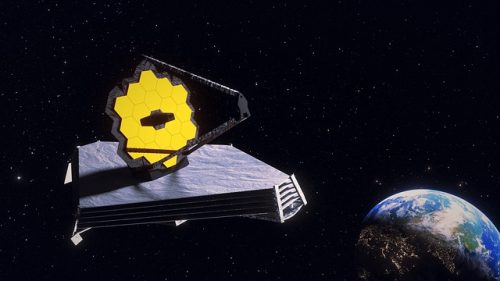A telescope travels back in time when looking further in deep space. The light the telescope receives takes a lot of time to travel through space. So we see the object not as it is now, but as it was emitting light that traveled through space for billions of years and reached us.
In order to see such a dark, distant object, the telescope needs a giant mirror that collects light. The size of a mirror in a telescope determines how sensitive the telescope is, or how detailed it can see. As the Webb telescope has a much larger mirror than the Hubble telescope, it can see the past much beyond.
How Does James Webb Space Telescope Functions?
The JWST is an infrared telescope which uses infrared light to detect objects in space. It observes celestial bodies such as stars, nebulae, and planets that are dying due to aging. Since these planets, stars and nebulae are too cold to see in visible light. Therefore, it is invisible to the human eye.
Infrared radiation cannot pass through gases and dust, so it is opaque to the human eye. The Hubble Telescope, on the other hand, sees visible light, ultraviolet light, and near infrared light.
Golden Mirror: Webb’s main mirror is 6.5 meters wide, making it the largest space telescope Webb has ever built. The mirror consists of 18 individually adjustable hexagonal gold-plated beryllium segments.
Webb’s primary mirror captures red and infrared light as it travels through space and reflects it on a smaller secondary mirror. A secondary mirror is then recorded by directing the light to the scientific instrument.
Sun Shield: To protect against the heat of the sun, Webb has a tennis court-sized sun visor. One of Webb’s equipment also has a cooling system to maintain its temperature. Because otherwise the heat from the sun (and Webb’s own equipment) could interfere with the telescope’s observations.
Each subsequent layer of the sun visor is colder than the previous one. It is made with very good insulation material with heat dissipation between the layers and the vacuum between the layers. One large, thick sun visor conducts heat from the bottom up through five vacuum-separated layers.
Also, the telescope observes very weak infrared signals, so it must be protected from bright, hot light sources such as the sun. There is a huge temperature difference between the hot and cold parts of a telescope separated by a sunshield.
Deployment: Webb was so large that it had to be folded like an origami piece to fit the Ariane 5 rocket launched into space. It will take about two weeks for Webb to fully open and another two weeks to reach his final destination.
High-frequency radio transmitters: Large radio antennas scattered around the world receive the Webb transmitter signal and relay it to the Webb Science and Operations Center at the Space Telescope Science Laboratory in Baltimore, USA.
How Is James Webb Space Telescope Pointed?
Webb rotates the observatory using six reaction wheels to rotate and point at various objects in space.
The reaction wheel is actually a flywheel that stores angular momentum. The effect of angular momentum is known as cycling.
It is much easier to stay on the bike when it’s moving than when it’s stationary, and the angular momentum of the spinning wheels makes the bike tend to go in a straight line in hands-free mode.
Slowing or accelerating one or more of Webb’s reaction wheels changes the total angular momentum of the entire station, so the station rotates to conserve angular momentum. Hubble also uses jet wheels to rotate to point at other objects.
Gyroscopes
Gyroscopes are used in combination with star tracker assemblies (STAs) to estimate the orientation of the observatory. In the Webb attitude control design, whose estimates are used to move the observatory from target to target, and maintain pointing on a target prior to fine guided and science operations. Usually, there are at least three gyroscopes that are oriented in three different directions that are needed to determine the orientation of the observatory.
Similarly, like Hubble and many other spacecraft, Webb begins life with a redundant set of working gyros, so multiple failures in gyroscopes may result in the loss of scientific capability, but unlike Hubble, Webb employs a very different kind of gyroscope.
Infrared Observations
Infrared observations are important in astronomy. This is because newly formed stars and planets are often obscured by clumps of dust that absorb visible light. Infrared can pass through these obstacles.
“Infrared rays travel around dust particles without jumping around, so you can see them with a Webb telescope. And that’s one of our main goals to see stars grow with young planets,” said John Mather, senior scientist on the Webb project at NASA’s Goddard Space Flight Center in Greenbelt, Maryland.
Spectrometer
A spectrometer is an instrument that can study the atmospheres of exoplanets. John Mather said finding one with lots of water is thought to be one of the key ingredients for life and it would be “really interesting.”He also said: “a wet little planet out there that might be a little bit like home.”
Communication Device
Webb uses high-frequency radio transmitters to send scientific and engineering data to Earth. A big radio antenna, which is a part of NASA’s Deep Space Network, will receive the signal and forward it to the Webb Science and Operations Center at the Space Telescope Science Laboratory in Baltimore, Maryland, USA.
